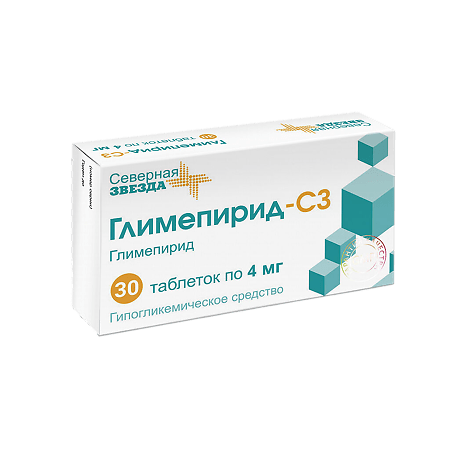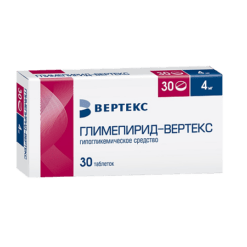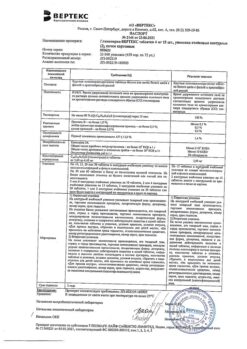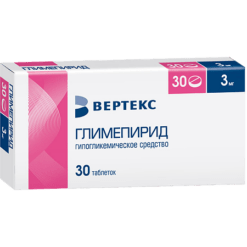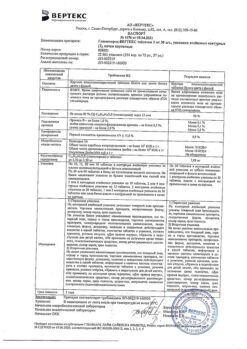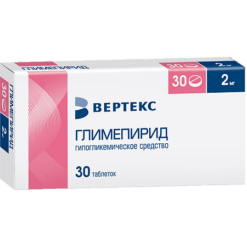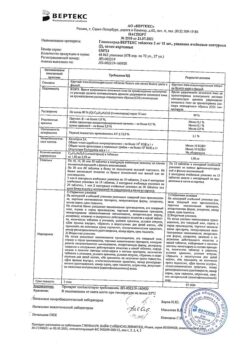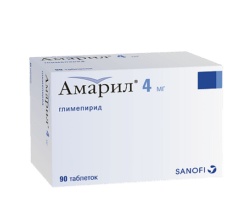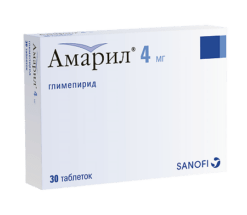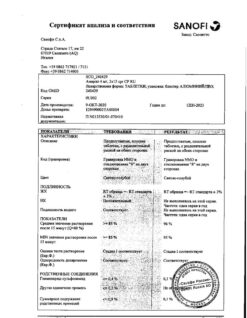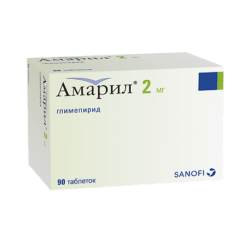No products in the cart.
Glimepiride-SZ, tablets 4 mg 30 pcs
€6.43 €5.63
Description
1 tablet contains:
active substance:
Glimepiride – 4 mg;
excipients: Mannitol – 130.4 mg, microcrystalline cellulose (102) – 24.0 mg, sodium carboxymethyl starch – 20.0 mg, povidone K 30 (polyvinylpyrrolidone medium molecular) – 2.6 mg, crospovidone (Collidon CL) – 18, 0 mg, magnesium stearate – 1.0 mg.
Active ingredient
Active ingredient
How to take, the dosage
How to take, the dosage
As a rule, the dose of Glimepiride-SZ is determined by the target blood glucose concentration. The lowest dose sufficient to achieve the necessary glycemic control should be used.
The blood glucose concentration should be determined regularly during treatment with Glimepiride-SZ. In addition, regular monitoring of glycated hemoglobin index is recommended.
If the drug is taken incorrectly, e.g. by skipping a dose, it should never be made up for by taking a higher dose afterwards.
Patient responses to Glimepiride-SZ errors (such as missing the next dose or skipping meals) or situations in which it is not possible to take the medication should be discussed between the patient and the physician in advance.
The drug Glimepiride-SZ is taken orally, whole, without chewing, with plenty of fluid (about 0.5 glasses). If necessary, the tablets can be divided along the risk into two equal parts.
The starting dose and dose selection
The starting dose is 1 mg of glimepiride once daily.
If necessary, the daily dose can be gradually (at 1-2 week intervals) increased. It is recommended to increase the dose under regular control of blood glucose concentration and in accordance with the following dose increase steps: 1 mg – 2 mg – 3 mg – 4 mg – 6 mg (- 8 mg).
Dose range in patients with well-controlled diabetes
The usual daily dose in patients with well-controlled diabetes is 1 to 4 mg of glimepiride. A daily dose of more than 6 mg is more effective only in a small number of patients.
The dosing regimen
The time of taking Glimepiride-SZ and the distribution of doses during the day is determined by the doctor depending on the patient’s lifestyle at a given time (time of meals, amount of physical activity).
In general, a single dose of the drug during a day is sufficient. It is recommended that in this case the whole dose of Glimepiride-SZ should be taken immediately before a full breakfast or, if it was not taken at this time, immediately before the first main meal. It is very important not to skip meals after taking Glimepiride-SZ tablets.
Because improved glycemic control is associated with increased insulin sensitivity, the need for glimepiride may decrease during treatment. In order to avoid the development of hypoglycemia, doses should be decreased or glimepiride-SZ should be discontinued in a timely manner.
Conditions in which it may also be necessary to adjust the dose of glimepiride:
– weight loss in patients;
– changes in the patient’s lifestyle (changes in diet, meal times, amount of physical activity);
– occurrence of other factors that lead to a predisposition to develop hypoglycemia or hyperglycemia (see See section “Special Precautions”).
The duration of treatment
The treatment with glimepiride is usually long-term.
Transferring a patient from another oral hypoglycemic drug to Glimepiride-SZ
There is no exact relationship between the doses of Glimepiride-SZ and other oral hypoglycemic drugs. When another oral hypoglycemic drug is replaced with Glimepiride-SZ, it is recommended that the algorithm of its prescription should be the same as for the initial use of glimepiride, that is, treatment should begin with the initial dose of 1 mg (even if the patient is transferred to glimepiride from the maximum dose of another oral hypoglycemic drug). Any dose escalation should be done in stages, taking into account the response to glimepiride, according to the above recommendations.
The strength and duration of the effect of the preceding oral hypoglycemic drug should be considered. Treatment may need to be interrupted in order to avoid any summation of effects, which may increase the risk of hypoglycemia.
Combination with metformin
In patients with insufficiently controlled diabetes when taking maximum daily doses of glimepiride or metformin, treatment with a combination of the two drugs may
be initiated. In this case, previous treatment with either glimepiride or metformin continues at the same dose level, and additional administration of metformin or glimepiride begins with a low dose, which is then titrated depending on the target level of glycemic control up to the maximum daily dose. Combination therapy should be started under close medical supervision.
The use in combination with insulin
Patients with insufficiently controlled diabetes when taking
the maximum daily doses of glimepiride may be simultaneously administered insulin. In this case, the last prescribed dose of glimepiride to the patient remains unchanged. In this case, treatment with insulin starts with low doses, which are gradually increased under control of blood glucose concentrations. Combined treatment requires close medical supervision.
The use in patients with renal impairment
There is limited information on the use of glimepiride in patients with renal impairment. Patients with impaired renal function may be more sensitive to the hypoglycemic effect of glimepiride (see sections “Pharmacokinetics”, “Contraindications”).
The use in patients with hepatic impairment
There is limited information on the use of glimepiride in hepatic impairment (see section “Contraindications”).
The use in children
There are not enough data on the use of the drug in children.
Interaction
Interaction
Glimepiride is metabolized by the CYP2C9 isoenzyme of cytochrome P450 system, which should be considered when using it simultaneously with inducers (e.g., rifampicin) or inhibitors (e.g., fluconazole) of CYP2C9.
Potentiation of hypoglycemic action and in some cases the associated possible development of hypoglycemia may be observed when combined with one of the following drugs:
Insulin and other oral hypoglycemic agents, angiotensin-converting enzyme (ACE) inhibitors, anabolic steroids and male sex hormones, chloramphenicol, coumarin derivatives, cyclophosphamide, fibrates fluoxetine, ifosfamide, monoamine oxidase inhibitors (MAOIs), fluconazole, para-aminosalicylic acid, pentoxifylline (high parenteral doses), phenylbutazone, probenecid, quinolones, salicylates, clarithromycin, sulfonamides, tetracyclines.
Worsening of hypoglycemic action and associated increase in blood glucose concentration may be observed when combined with one of the following drugs:
Acetazolamide, barbiturates, glucocorticosteroids, diuretics, epinephrine and other sympathomimetic agents, glucagon, laxatives (with long-term use), nicotinic acid (in high doses), estrogens and progestogens, phenothiazines, phenytoin, rifampicin, iodine-containing thyroid hormones.
H2-histamine receptor blockers, beta-adrenoblockers, clonidine and reserpine can both increase and decrease the hypoglycemic effect of glimepiride.
The signs of adrenergic counter-regulation in response to hypoglycemia may be reduced or absent under the influence of sympatholytic agents such as beta-adrenoblockers, clonidine and reserpine.
The effect of coumarin derivatives may be increased or decreased with glimepiride administration.
Single or chronic alcohol consumption may both enhance or weaken the hypoglycemic effect of glimepiride.
Bile acid sequestrants: colesevelam binds to glimepiride and reduces the absorption of glimepiride from the gastrointestinal tract. In the case of glimepiride administration at least 4 h before taking colesevelam, no interaction is observed. Therefore, glimepiride should be taken at least 4 hours before taking coloselam.
Contraindications
Contraindications
Diabetes mellitus type 1;
Diabetic ketoacidosis, diabetic precoma, and coma;
Hypersensitivity to glimepiride or to any excipient of the drug, to other sulfonylurea derivatives, or to other sulfonamides (risk of hypersensitivity reactions);
Severe hepatic impairment (no history of clinical use);
Severe renal impairment, including in patients on glycoprotein.
Prenatal and breastfeeding conditions;
in children and adolescents
under 18 years of age (lack of clinical experience).
In the first weeks of treatment (increased risk of hypoglycemia).
If risk factors for hypoglycemia are present (see Special Precautions, adjustments to glimepiride dose or all therapy may be required).
In case of intercurrent illnesses during treatment or when patients change their lifestyle (changes in diet and meal times, increased or decreased physical activity).
In glucose-6-phosphate dehydrogenase deficiency.
In disorders of absorption of food and drugs in the gastrointestinal tract (GIT) (intestinal obstruction, intestinal paresis).
Side effects
Side effects
Adverse reactions during glimepiride administration are presented according to the World Health Organization (WHO) classification: Very common (â¥10%), common (â¥1%, < 10%), infrequent (â¥0.1%, < 1%), rare (â¥0.01%, < 0.1%), very rare, including individual reports
(< 0.01%), frequency unknown (the frequency cannot be determined from available data).
Metabolic disorders
Hypoglycemia
Hypoglycemia may occur as a result of the hypoglycemic action of Glimepiride-SZ, which, as with other sulfonylurea derivatives, may be prolonged.
The symptoms of hypoglycemia are: headache, acute feeling of hunger, nausea, vomiting, feeling of fatigue, drowsiness, sleep disturbances, restlessness, aggressiveness, impaired concentration and speed of psychomotor reactions, depression, confusion, speech disorders, aphasia, visual disturbances, tremor, paresis, sensory disturbances, dizziness, loss of self-control, helplessness, delirium, cerebral convulsions, somnolence or loss of consciousness up to coma, shallow breathing, bradycardia.
In addition, there may be manifestations of adrenergic counter-regulation in response to the development of hypoglycemia, such as: increased sweating, cold and wet skin, increased anxiety, tachycardia, increased blood pressure, angina, “palpitations” and heart rhythm disturbances.
The clinical picture of severe hypoglycemia can be similar to a stroke.
The symptoms of hypoglycemia almost always disappear after it is resolved.
Body weight gain
Body weight gain (frequency unknown) may occur when taking glimepiride, as well as other sulfonylurea derivatives.
Visual disturbances
Transient visual disturbances due to changes in blood glucose concentrations may be observed during treatment (especially at the beginning of treatment). These are caused by a temporary change in lens swelling, which depends on the blood glucose concentration and thus changes the refractive index of the lens.
Gastrointestinal disorders
Rarely: nausea, vomiting, a feeling of heaviness or congestion in the epigastrium, abdominal pain, diarrhea.
Prevalence unknown: dysgeusia (taste disorders).
Liver and biliary tract disorders
In isolated cases: Hepatitis, increased activity of “hepatic” enzymes and/or cholestasis and jaundice, which may progress to life-threatening liver failure, but may undergo reversal when the drug is withdrawn
Blood and lymphatic system disorders
Rarely: thrombocytopenia.
In isolated cases: leukopenia, hemolytic anemia, erythrocytopenia,
granulocytopenia, agranulocytosis and pancytopenia.
Prevalence unknown: Cases of severe thrombocytopenia with platelet counts less than 10000/μL and thrombocytopenic purpura have been reported during post-registration use of the drug.
Immune system disorders
Rarely: allergic and pseudoallergic reactions such as itching, urticaria, skin rash. These reactions are almost always mild, but may progress to severe reactions with dyspnea, a sharp decrease in blood pressure, which sometimes progress to anaphylactic shock. If symptoms of urticaria occur, you should consult a doctor immediately. Cross-allergy with other sulfonylurea derivatives, sulfonamides or similar substances is possible.
In isolated cases: allergic vasculitis.
Skin and subcutaneous tissue disorders
In isolated cases: photosensitization.
Prevalence unknown: alopecia.
Laboratory and instrumental findings
In isolated cases: hyponatremia.
Overdose
Overdose
Symptoms of overdose
An acute overdose, as well as long-term treatment with too high doses of glimepiride may lead to severe life-threatening hypoglycemia.
The treatment of an overdose
As soon as an overdose is detected, a physician should be informed immediately. Hypoglycemia can almost always be quickly controlled with immediate intake of carbohydrates (glucose or a piece of sugar, sweet fruit juice or tea). The patient should therefore always carry at least 20 g of glucose (4 lumps of sugar). Sugar substitutes are ineffective in the treatment of hypoglycemia.
Till such time as the physician decides that the patient is out of danger, close medical observation of the patient is necessary. Keep in mind that hypoglycemia may recur after the initial recovery of blood glucose concentrations.
If a patient with diabetes is treated by different doctors (e.g., during a hospital stay after an accident, during a weekend illness), they should be sure to tell them about their condition and previous treatment.
Sometimes a patient may need to be hospitalized, even if only as a precaution. Significant overdose and severe reactions with manifestations such as loss of consciousness or other serious neurological disorders are medical emergencies and require immediate treatment and hospitalization,
If the patient is unconscious, intravenous infusion (IV) of concentrated dextrose (glucose) solution (starting with 40 ml of a 20% solution in adults) is necessary. Alternatively, subcutaneous or intramuscular administration of glucagon in adults at a dose of 0.5 to 1 mg is possible.
In the treatment of hypoglycemia due to accidental administration in infants or young children, the dose of dextrose administered should be carefully adjusted to the possibility of dangerous hyperglycemia, and dextrose administration should be performed under continuous monitoring of blood glucose concentrations.
In case of glimepiride overdose, gastric lavage and administration of activated charcoal may be necessary.
After rapid recovery of blood glucose concentrations, an intravenous infusion of dextrose solution at a lower concentration is necessary to prevent recurrence of hypoglycemia. Blood glucose concentration in such patients should be constantly monitored for 24 hours. In severe cases with a prolonged course of hypoglycemia, the risk of blood glucose concentration decrease to hypoglycemic levels may persist for several days.
Pregnancy use
Pregnancy use
Glimepiride is contraindicated in pregnant women. In case of a planned pregnancy or if pregnancy occurs, the woman should be transferred to insulin therapy.
Glimepiride penetrates into breast milk, so it should not be taken during breastfeeding. In this case, it is necessary to switch to insulin therapy or stop breastfeeding.
Similarities
Similarities
Additional information
| Weight | 0.020 kg |
|---|---|
| Manufacturer | North Star NAO, Russia |
| Medication form | pills |
| Brand | North Star NAO |
Other forms…
Related products
Buy Glimepiride-SZ, tablets 4 mg 30 pcs with delivery to USA, UK, Europe and over 120 other countries.

